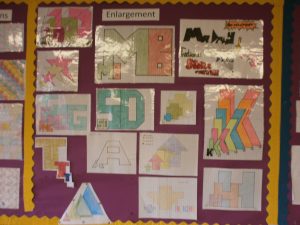OVERVIEW – MATHEMATICS
Overview – Maths
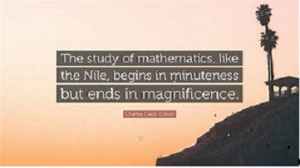
Members of Department:
HOD: Mrs A Connolly
Teachers:
Miss M Barrett
Mrs J Gallagher (Numeracy Co-ordinator)
Miss M Robinson
Mrs C Owens
Introduction
Mathematics evolved from counting, calculation, measurement and the systematic study of shapes and motions of physical objects. Mathematics can be subdivided into the study of quantity, structure, shape and change. Mathematicians seek out patterns, formulate new conjectures and at the highest level, establish truth by rigorous deduction from appropriately chosen axioms and definitions.
Department Aims
In this department we aim to:
• Develop knowledge and understanding of Number, Algebra, Shape and Data Handling.
• Develop pupil confidence in the precise use of mathematical language and notation as an effective means of communication.
• Develop increasing competence in mental mathematics skills, pencil & paper methods, practical skills in use of technology.
• Develop the ability to apply mathematical skills to other General Learning Areas.
• Develop the application of mathematical skills to real-life and work situations – increasing pupil awareness of STEM initiative.
• Develop knowledge and understanding of personal finance issues.
• Provide opportunities for pupils to develop Thinking Skills & Personal Capability in the fields of Problem-Solving & Decision Making, Self-Management, Working with Others, Managing Information and Being Creative.
• Stimulate student’s interest, curiosity and enjoyment of Mathematics, acquiring a suitable foundation appropriate to the study of the subject at a higher level.
• Assist pupils in gaining necessary Mathematical qualifications for their chosen courses/careers.
• Identify and support high/low attainers in their study of Mathematics.
• Encourage all pupils to achieve at their highest potential.
• Encourage pupils to “have a go” irrespective of mathematical ability, promoting self-esteem and an appreciation and sensitivity to varying levels of ability within a class group.
• Provide opportunities for a wider enjoyment of the subject through active teaching & learning strategies and participation in class, school and national competitions.
• Promote development in Mathematics as a shared learning process between pupil, parent and staff.
The members of the Mathematics Department are committed to and actively promote the school ethos in policy and practice.
Key Stage 3

Years 8, 9 and 10 students follow a rich and varied programme in Mathematics in line with the Revised Curriculum for Northern Ireland. Students are taught in their Form Class mixed ability groups. All Key Stage 3 students have 5 × 35 minute periods per week. The level of attainment at the end of Key Stage 3 Mathematics will be used to determine class groupings for GCSE Mathematics in Key Stage 4.
| NUMBER | ALGEBRA | GEOMETRY/MEASURES | STATISTICS/PROBABILITY |
|---|---|---|---|
| Language of Number Whole Numbers Decimals Fractions/%/Decimals Negative Numbers Calculator Primes/HCF/LCM Reciprocals Fractions Percentages/Finance dp/sf/calculator Error in Measurement Estimation Ratio Binary Numbers | Basic Algebra Brackets/Common Factors Function Machines/Substitution Linear Equations Co-ordinates (midpoint of a line) Sequences Formulae Linear Equations (cross multiplication) Trial & Improvement Straight Line Graph Simultaneous Equations by Graph Indices Quadratic Brackets Inequalities (numberlines) Real-life Graphs – Travel Graphs, Conversion Graphs, Linear Contextual Graphs | 2D/3D Shapes Line & Angle Triangles/Constructions Circle Metric System Time Perimeter/area/volume – square, rectangle, triangle, cube, cuboid, compound shapes Angle Properties Quadrilaterals Polygons Symmetry/Tessellations Imperial System Perimeter/area/volume - quadrilaterals Pythagoras (length of a line) Turning/Bearings Transformations (reflection, rotation, enlargement, translation) Compound Measures (SDT) Perimeter/area/volume – circle, compound shapes, prisms. | Collection of Data Data Display – tally charts, frequency tables, bar charts, line graphs, pie charts, scatter graphs, frequency polygons, stem and leaf. Analysing Data – mean, mode, median, range Probability |
In delivery of the above topics students will have opportunities to develop:
• knowledge and understanding of personal finance issues, and skills to enable competent and responsible financial decision making;
• the application of mathematical skills to real life and work situations;
• the creative use of technology to enhance mathematical understanding.
by demonstrating:
• creative thinking in their approach to solving mathematical problems;
• increasing competence in mental mathematics skills;
• increasing competence in pencil and paper methods;
• increasing confidence in the use of mathematical language and notation;
• practical skills using technology.
The ‘Key Elements’ and ‘Thinking Skills and Personal Capabilities’ identified in the Revised Curriculum are also an integral part of the Key Stage 3 Mathematics programme of study. Tasks undertaken throughout Key Stage 3 Mathematics support the Cross-Curricular Skills of Using Mathematics, Communication and ICT.
Pupil work from Key Stage 3
Year 8 – Special Numbers

Year 8 – Coordinates
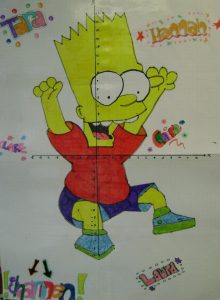
Year 8 – Fun with Factors
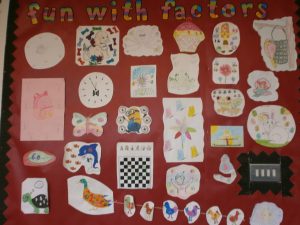
Year 9 Tessellations
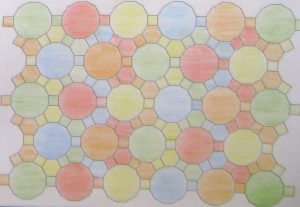
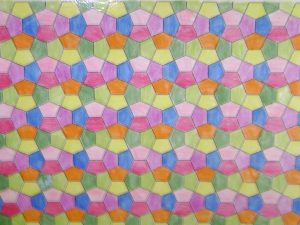
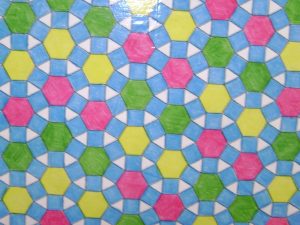
Year 9 Quadrilaterals
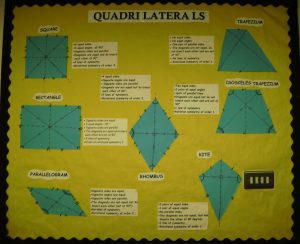
Year 10 Enlargement
